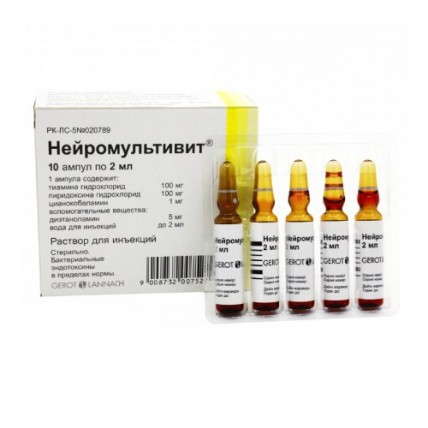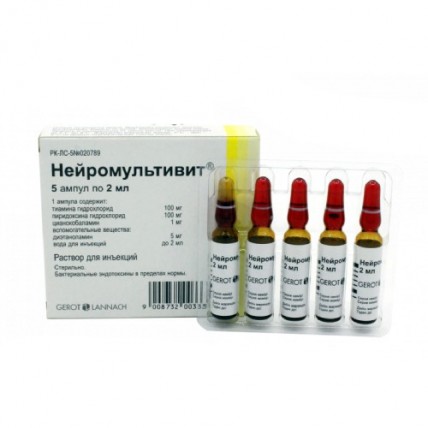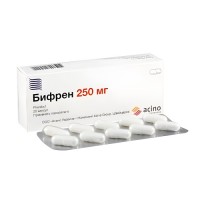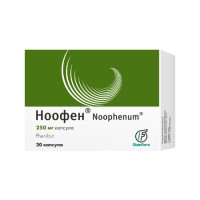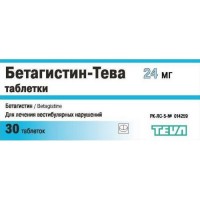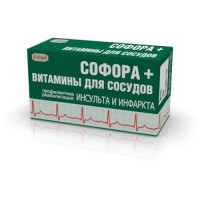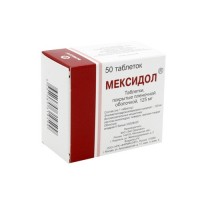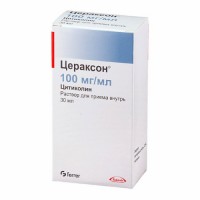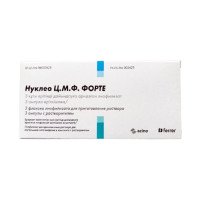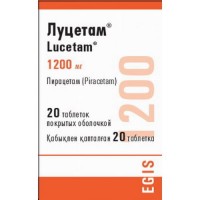Neuromultivit® - a complex of B vitamins!
The pharmacological properties of the drug are determined by the properties of the vitamins that make up the drug.
Thiamine (vitamin B1) in the human body, as a result of phosphorylation processes, is converted into cocarboxylase, which is a coenzyme of many enzymatic reactions. Thiamine plays an important role in carbohydrate, protein and fat metabolism. It actively participates in the processes of conducting nervous excitement in synapses.
Pyridoxine (vitamin B6) is essential for the normal functioning of the central and peripheral nervous system. In phosphorylated form, it is a coenzyme in the metabolism of amino acids (decarboxylation, transamination, etc.). Acts as a coenzyme of the most important enzymes acting in nerve tissues. Participates in the biosynthesis of many neurotransmitters, such as dopamine, norepinephrine, adrenaline, histamine and GABA, participating in the exchange of glutamic acid.
Cyanocobalamin (vitamin B12) is necessary for normal hematopoiesis and erythrocyte maturation, and also participates in a number of biochemical reactions that ensure the vital activity of the body - in the transfer of methyl groups, in the synthesis of nucleic acids, protein, in the exchange of amino acids, carbohydrates, lipids. It has a beneficial effect on the processes in the nervous system (synthesis of nucleic acids and the lipid composition of cerebrosides and phospholipids). The coenzyme forms of cyanocobalamin, methylcobalamin and adenosylcobalamin, are required for cell replication and growth.
2 ml of solution contains active substances:
excipients: diethanolamine, water for injection
Pharmacokinetics
The drug contains a combination of B vitamins: thiamine hydrochloride (B1), pyridoxine hydrochloride (B6) and cyanocobalamin (B12).
Water-soluble vitamins are completely absorbed in the body after intramuscular administration.
Thiamine hydrochloride (vitamin B1). Part of the absorbed thiamine hydrochloride takes part in enterohepatic circulation. The main excretion products of thiamine hydrochloride are thiamincarboxylic acid and pyramine (2,5-dimethyl-4-aminopyrimidine). Along with this, a small amount of thiamine hydrochloride is released unchanged.
Pyridoxine hydrochloride (vitamin B6). In the body, pyridoxine hydrochloride is oxidized to pyridoxal or aminated to pyridoxamine. The condition for its functioning as a coenzyme is phosphorylation at the CH2OH group in the 5th position, that is, the formation of pyridoxal-5-phosphate (PALP). In the blood, approximately 80% of PALPs are bound to proteins. Pyridoxine hydrochloride is predominantly accumulated in muscles in the form of PALP. The main product of excretion is 4-pyridoxinic acid.
Cyanocobalamin (vitamin B12). After absorption, vitamin B12 binds in serum to specific B12-binding beta (transcobalamin) and B12-binding alpha1 globulin. The accumulation of vitamin B12 occurs mainly in the liver. The half-life from serum is approximately 5 days, and from the liver is approximately 1 year.
Pharmacodynamics
Neuromultivit® contains a combination of B vitamins, which are especially needed as coenzymes in the intermediate metabolism of the central and peripheral nervous system. Like all vitamins, they are an integral part of the diet and cannot be produced by the body on its own. Supplementation of these vitamins to the diet in therapeutic doses helps to balance any existing deficiencies, thus ensuring the production of the required amount of coenzymes. Joint administration in large doses is considered more effective than the use of the components Separately, especially when it is necessary to quickly correct an acute vitamin deficiency.
The therapeutic use of these vitamins for disorders of the nervous system prevents the manifestation of concomitant deficiency states (sometimes caused by increased demand due to a previous illness) on the one hand, and also stimulates the natural mechanism of debugging the other side. At the same time, the analgesic effect of the B complex vitamins enhances the healing effect.
The active form of vitamin B1 (thiamine) is thiamine diphosphate. During carbohydrate metabolism, it acts as a coenzyme to decarboxylate alpha-keto acids such as pyruvate and alpha-ketoglutarate. Thiamine, present in the membranous nerve tissue, affects nerve function through the biosynthesis of neurotransmitters.
Vitamin B6 (pyridoxine) is a coenzyme essential for the metabolism of amino acids, acting as a prosthetic group of important enzymes in the nervous tissue. Thus, Pyridoxine affects the biosynthesis and concentration of several neurotransmitters such as dopamine, norepinephrine, 5 hydroxytryptamine, histamine, and GABA. Pyridoxine plays an important role in the conversion of homocysteine to cysteine, as well as in the resynthesis of homocysteine to methionine.
Vitamin B12 (cyanocobalamin) affects the synthesis of nucleic acids and the composition of fatty acids in neuronal cerebrosides and phospholipids. As it is a coenzyme, it has an important function in cell growth and in the replication process, for example also in the resynthesis of homocysteine to methionine.
- polyneuropathy of various origins
- neuritis and neuralgia
- radiculoneuritis due to degenerative diseases of the spine (cervical syndrome, hand and forearm cider, lumbar syndrome)
- sciatica
- trigeminal neuralgia, intercostal neuralgia
The drug is injected only intramuscularly (in the upper outer quadrant of the gluteus maximus muscle).
In severe, acute conditions: 1 injection a day until the relief of the syndrome.
For mild conditions: 1 injection 2-3 times a week.
Very rare <1-10,000
- hypersensitivity reactions (mainly in the form of skin manifestations)
- anaphylactic reactions
- neurological disorders such as sensory neuropathy with loss of reflexes, ataxia, impairment of superficial and deep sensory functions, sympathoplegia
- hypersecretion of hydrochloric acid
- hypersensitivity to active or auxiliary substances of the drug
- erythremia, erythrocytosis
- pregnancy and lactation
- hypervitaminosis of B vitamins
- children's age up to 18 years
Thiamine solution is incompatible with solutions of dopamine, methoxantrone, pyridoxal phosphate.
When administered concomitantly with L-dopa, Vitamin B6 may reduce its effects. Pyridoxine weakened an antitumor effect of altretamine.
Pyridoxine enhances the hypoglycemic effect of glimepiride, insulin and the combination of glibenclamide + metformin.
Cyanocobalamin is incompatible with ascorbic acid, heavy metal salts and pyridoxal phosphate.
Lansoprazole slows down the absorption of cyanocobalamin, mesalazine slows down its absorption.
Aminoglycosides, salicylates, antiepileptic drugs, colchicine, potassium preparations - reduce the absorption of vitamin B12.
The combination of thiamine + pyridoxine + cyanocobalamin is incompatible with ascorbic acid, benzylpenicillin, dextrose, riboflavin, phenobarbital.
When combined with epinephrine and norepinephrine, their side effects on the heart may increase.
Neuromultivitis, injection solution should not be mixed with other medications.
Cannot be administered for acute thromboembolic diseases. Exercise caution in persons prone to thrombosis with angina pectoris. It is necessary to control blood clotting.
It is used with caution in case of gastric ulcer and duodenal ulcer, ischemic heart disease.
With severe liver damage, it can cause a deterioration in its function.
Features of the effect of the drug on the ability to drive a vehicle or potentially dangerous mechanisms
Neuromultivitis affects the ability to drive vehicles. Care should be taken when driving vehicles and working with potentially dangerous machinery.
Overdose can occur only after the administration of extremely large doses for a long period.
Symptoms: neuropathy with ataxia, impaired sensory functions, convulsions with EEG changes, hypochromic anemia, dermatitis.
Treatment: symptomatic therapy.
Store in a dark place at temperatures from 20C to 80C.
Keep out of the reach of children!
Shelf life - 3 years
Do not use the drug after the expiration date.
The pharmacological properties of the drug are determined by the properties of the vitamins that make up the drug.
Thiamine (vitamin B1) in the human body, as a result of phosphorylation processes, is converted into cocarboxylase, which is a coenzyme of many enzymatic reactions. Thiamine plays an important role in carbohydrate, protein and fat metabolism. It actively participates in the processes of conducting nervous excitement in synapses.
Pyridoxine (vitamin B6) is essential for the normal functioning of the central and peripheral nervous system. In phosphorylated form, it is a coenzyme in the metabolism of amino acids (decarboxylation, transamination, etc.). Acts as a coenzyme of the most important enzymes acting in nerve tissues. Participates in the biosynthesis of many neurotransmitters, such as dopamine, norepinephrine, adrenaline, histamine and GABA, participating in the exchange of glutamic acid.
Cyanocobalamin (vitamin B12) is necessary for normal hematopoiesis and erythrocyte maturation, and also participates in a number of biochemical reactions that ensure the vital activity of the body - in the transfer of methyl groups, in the synthesis of nucleic acids, protein, in the exchange of amino acids, carbohydrates, lipids. It has a beneficial effect on the processes in the nervous system (synthesis of nucleic acids and the lipid composition of cerebrosides and phospholipids). The coenzyme forms of cyanocobalamin, methylcobalamin and adenosylcobalamin, are required for cell replication and growth.
Compound
2 ml of solution contains active substances:
- Vitamin B1 (Thiamine Hydrochloride) - 100 mg
- Vitamin B6 (Pyridoxine Hydrochloride) - 100 mg
- Vitamin B12 (Cyanocobalamin) - 1 mg,
excipients: diethanolamine, water for injection
Pharmacological properties
Pharmacokinetics
The drug contains a combination of B vitamins: thiamine hydrochloride (B1), pyridoxine hydrochloride (B6) and cyanocobalamin (B12).
Water-soluble vitamins are completely absorbed in the body after intramuscular administration.
Thiamine hydrochloride (vitamin B1). Part of the absorbed thiamine hydrochloride takes part in enterohepatic circulation. The main excretion products of thiamine hydrochloride are thiamincarboxylic acid and pyramine (2,5-dimethyl-4-aminopyrimidine). Along with this, a small amount of thiamine hydrochloride is released unchanged.
Pyridoxine hydrochloride (vitamin B6). In the body, pyridoxine hydrochloride is oxidized to pyridoxal or aminated to pyridoxamine. The condition for its functioning as a coenzyme is phosphorylation at the CH2OH group in the 5th position, that is, the formation of pyridoxal-5-phosphate (PALP). In the blood, approximately 80% of PALPs are bound to proteins. Pyridoxine hydrochloride is predominantly accumulated in muscles in the form of PALP. The main product of excretion is 4-pyridoxinic acid.
Cyanocobalamin (vitamin B12). After absorption, vitamin B12 binds in serum to specific B12-binding beta (transcobalamin) and B12-binding alpha1 globulin. The accumulation of vitamin B12 occurs mainly in the liver. The half-life from serum is approximately 5 days, and from the liver is approximately 1 year.
Pharmacodynamics
Neuromultivit® contains a combination of B vitamins, which are especially needed as coenzymes in the intermediate metabolism of the central and peripheral nervous system. Like all vitamins, they are an integral part of the diet and cannot be produced by the body on its own. Supplementation of these vitamins to the diet in therapeutic doses helps to balance any existing deficiencies, thus ensuring the production of the required amount of coenzymes. Joint administration in large doses is considered more effective than the use of the components Separately, especially when it is necessary to quickly correct an acute vitamin deficiency.
The therapeutic use of these vitamins for disorders of the nervous system prevents the manifestation of concomitant deficiency states (sometimes caused by increased demand due to a previous illness) on the one hand, and also stimulates the natural mechanism of debugging the other side. At the same time, the analgesic effect of the B complex vitamins enhances the healing effect.
The active form of vitamin B1 (thiamine) is thiamine diphosphate. During carbohydrate metabolism, it acts as a coenzyme to decarboxylate alpha-keto acids such as pyruvate and alpha-ketoglutarate. Thiamine, present in the membranous nerve tissue, affects nerve function through the biosynthesis of neurotransmitters.
Vitamin B6 (pyridoxine) is a coenzyme essential for the metabolism of amino acids, acting as a prosthetic group of important enzymes in the nervous tissue. Thus, Pyridoxine affects the biosynthesis and concentration of several neurotransmitters such as dopamine, norepinephrine, 5 hydroxytryptamine, histamine, and GABA. Pyridoxine plays an important role in the conversion of homocysteine to cysteine, as well as in the resynthesis of homocysteine to methionine.
Vitamin B12 (cyanocobalamin) affects the synthesis of nucleic acids and the composition of fatty acids in neuronal cerebrosides and phospholipids. As it is a coenzyme, it has an important function in cell growth and in the replication process, for example also in the resynthesis of homocysteine to methionine.
Indications for use
- polyneuropathy of various origins
- neuritis and neuralgia
- radiculoneuritis due to degenerative diseases of the spine (cervical syndrome, hand and forearm cider, lumbar syndrome)
- sciatica
- trigeminal neuralgia, intercostal neuralgia
Method of administration and dosage
The drug is injected only intramuscularly (in the upper outer quadrant of the gluteus maximus muscle).
In severe, acute conditions: 1 injection a day until the relief of the syndrome.
For mild conditions: 1 injection 2-3 times a week.
Side effects
Very rare <1-10,000
- hypersensitivity reactions (mainly in the form of skin manifestations)
- anaphylactic reactions
- neurological disorders such as sensory neuropathy with loss of reflexes, ataxia, impairment of superficial and deep sensory functions, sympathoplegia
- hypersecretion of hydrochloric acid
Contraindications
- hypersensitivity to active or auxiliary substances of the drug
- erythremia, erythrocytosis
- pregnancy and lactation
- hypervitaminosis of B vitamins
- children's age up to 18 years
Drug interactions
Thiamine solution is incompatible with solutions of dopamine, methoxantrone, pyridoxal phosphate.
When administered concomitantly with L-dopa, Vitamin B6 may reduce its effects. Pyridoxine weakened an antitumor effect of altretamine.
Pyridoxine enhances the hypoglycemic effect of glimepiride, insulin and the combination of glibenclamide + metformin.
Cyanocobalamin is incompatible with ascorbic acid, heavy metal salts and pyridoxal phosphate.
Lansoprazole slows down the absorption of cyanocobalamin, mesalazine slows down its absorption.
Aminoglycosides, salicylates, antiepileptic drugs, colchicine, potassium preparations - reduce the absorption of vitamin B12.
The combination of thiamine + pyridoxine + cyanocobalamin is incompatible with ascorbic acid, benzylpenicillin, dextrose, riboflavin, phenobarbital.
When combined with epinephrine and norepinephrine, their side effects on the heart may increase.
Special instructions
Neuromultivitis, injection solution should not be mixed with other medications.
Cannot be administered for acute thromboembolic diseases. Exercise caution in persons prone to thrombosis with angina pectoris. It is necessary to control blood clotting.
It is used with caution in case of gastric ulcer and duodenal ulcer, ischemic heart disease.
With severe liver damage, it can cause a deterioration in its function.
Features of the effect of the drug on the ability to drive a vehicle or potentially dangerous mechanisms
Neuromultivitis affects the ability to drive vehicles. Care should be taken when driving vehicles and working with potentially dangerous machinery.
Overdose
Overdose can occur only after the administration of extremely large doses for a long period.
Symptoms: neuropathy with ataxia, impaired sensory functions, convulsions with EEG changes, hypochromic anemia, dermatitis.
Treatment: symptomatic therapy.
Storage conditions
Store in a dark place at temperatures from 20C to 80C.
Keep out of the reach of children!
Shelf life - 3 years
Do not use the drug after the expiration date.
